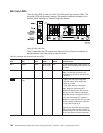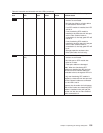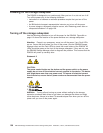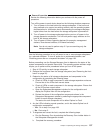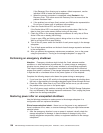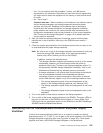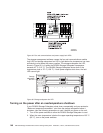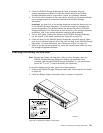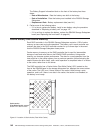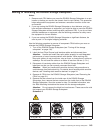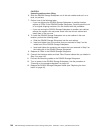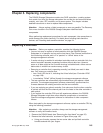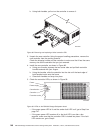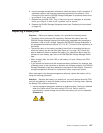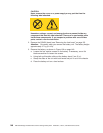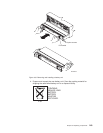
The Battery Support Information label on the front of the battery has three
dates:
v Date of Manufacture - Date the battery was built at the factory
v Date of Installation - Date the battery was installed in the DS4500 Storage
Subsystem
v Replacement Date - Battery replacement date (see 141)
3.
Perform one of the following tasks:
v If it is time to replace the battery, install a new battery using the procedure
described in “Replacing a battery unit” on page 147.
v If it is not time to replace the battery, replace the DS4500 Storage Subsystem
bezel (see “Replacing the front bezel” on page 44).
Cache battery and cache memory
Each RAID controller in the DS4500 Storage Subsystem contains 1 GB of cache
memory to store read and write operations. The battery unit in each controller can
maintain the data in the RAID controller caches for up to three days in the event
that the DS4500 Storage Subsystem loses power.
Cache memory is memory on the RAID controller that is used for intermediate
storage of read and write data on the DS4500 RAID controllers. Using cache
memory can increase system performance. The data for a read operation from the
host might be in the cache memory from a previous operation (thus eliminating the
need to access the drive itself), and a write operation is completed when it is written
to the cache, rather than to the drives.
The RAID controller has a Cache Active (Fast Write Cache) LED, located on the
front of the DS4500 bezel or the storage subsystem fan, displays the current status
of the cache. The LED is on if there is data in the cache, blinks during a write
operation, and is off if there is no data in the cache, the cache is not enabled, or
the battery is not ready.
Cache active
(Fast Write Cache)
Green LED: data in cache
GS000049b
Figure 97. Location of Cache Active (Fast Write Cache)
142 IBM TotalStorage DS4500 Fibre Channel Storage Subsystem: Installation, User’s, and Maintenance Guide



